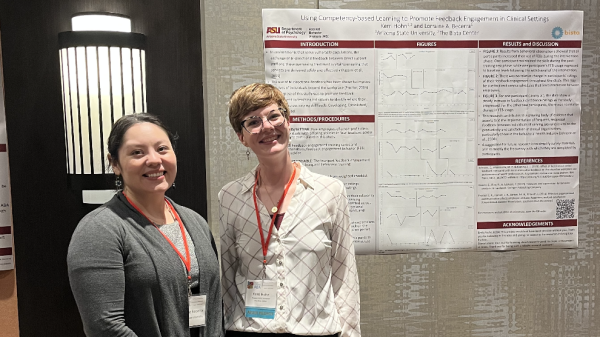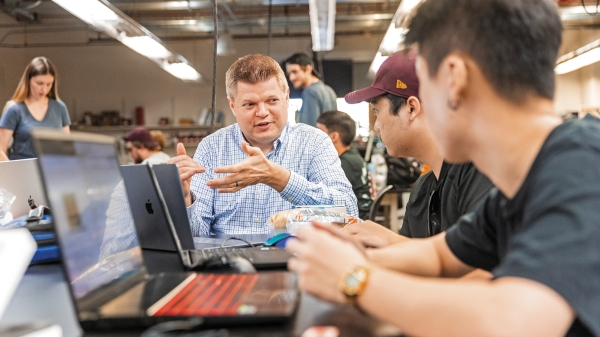Nature Research and Biodesign to co-host fall conference on imaging molecular reactions

The “Functional dynamics – visualizing molecules in action” conference will come to Arizona State University’s Tempe campus Nov. 6-8.
Some of the world’s most accomplished scientific minds will converge on Arizona State University’s Tempe campus Nov. 6-8 to explore new methods that make it possible to observe molecules in action. Illustrating the adage "seeing is believing," the conference, “Functional dynamics – visualizing molecules in action,” will showcase how cutting-edge methods are pushing the boundaries of knowledge.
At the conference, scientists will discuss how emerging methods that were unthinkable a decade ago have the potential to change the trajectory of drug discovery, accelerate the search for new sources of energy, miniaturize semiconductors – and even preserve art and archeology.
“The conference will bring together scientists from all over the world, working in disciplines ranging from structural biology, ultrafast spectroscopy and theory to quantum physics, to present and discuss novel breakthrough techniques and discoveries that will allow us to see the world around us ‘with new eyes’ by imaging molecular dynamics at the atomic scale,” said Petra Fromme, director of the Biodesign Center for Applied Structural Discovery, Regents Professor in the School of Molecular Sciences and a member of the conference's scientific committee. To date, most structural knowledge is based on a static picture of the molecules or the material, limiting understanding because of the highly dynamic nature of living organisms, chemical reactions and transitions in materials.
“I am especially thrilled about the potential of this gathering because it is the first time the esteemed Nature editors have selected Arizona State University as a site for one of their prestigious conferences,” said Fromme.
“We are also eager to show conference participants the progress we've made with our prototype compact femtosecond X-ray light source,” said William Graves, lead accelerator physicist for the project and associate professor of physics. Participants will have the rare opportunity to visit the Beus CXFEL Laboratory, where scientists will be making final preparations for the first light experiment.
The conference is co-organized by seven Nature journal editors and noted researchers at ASU. The ASU team is led by Fromme, Graves and John Spence, the Richard Snell Professor of Physics at ASU. Nature senior editor Magdalena Helmer is leading the Nature team, along with editors from Nature, Nature Chemistry, Nature Communications, Nature Methods and Nature Physics. Many of the Nature publication editors plan to attend the conference.
In assessing sites and scientists for a conference that would be well-positioned to advance techniques such as serial femtosecond crystallography and ultrafast spectroscopy, among other related technologies, the Nature editors identified Fromme and her team as leading the field, issuing an invitation to Fromme and the Biodesign Institute to host this important conference.
The conference will feature five sessions, designed to stimulate new ideas and collaborations. The conference will include a poster session and presentations in five key areas of interest:
- Mapping ultra-fast light-triggered molecular motion
- Visualizing catalysis in real time
- Energy transfer and excited-state dynamics
- Dynamics of interfaces
- Tracking large-scale molecular dynamics
The conference committee will invite those who have submitted the best abstracts to provide short talks at the conference.
The event is expected to draw a broad mix of scientists, representing an unusually wide array of disciplines. Speakers include two Nobel Laureates: Ada Yonath, who received the Nobel Prize in Chemistry in 2009 for unravelling the atomic basis of protein synthesis in living cells by solving the structure of the ribosome; and Brian Kobilka, who received the Nobel Prize in Chemistry in 2012 for his pioneering work in solving the structure of one of the most promising drug-targets, a G-protein coupled receptor with its G-protein.
"This is a line-up of superstars," said Spence. "The inexpensive room-sized compact X-ray free-electron laser will bring these femtosecond X-ray diffraction, imaging and spectroscopy techniques within reach of campuses and industrial labs across the country. This conference will showcase all the resulting research opportunities."
It is anticipated that this compact version of a free electron laser will be far more accessible and affordable than the five massive linear accelerators that currently exist worldwide. ASU’s compact X-ray free electron laser will place power in the hands of researchers who develop novel techniques for biomedical imaging in the form of phase contrast imaging and the formation of molecular movies of biomolecules at work, which will help scientists find new solutions to the treatment of cancer, diabetes, infections and many other chronic diseases. The instrument will also be used for the development of new materials with novel properties, a development that may lead to new breakthroughs in the field of quantum materials.
The conference will feature the following invited speakers:
Hashim Al-Hashimi (Duke University, USA)
Henry Chapman (DESY and University of Hamburg, Germany)
Lin Chen (Northwestern University, USA)
Paul Corkum (University of Ottawa, Canada)
Roberta Croce (VU Amsterdam, The Netherlands)
Tanja Cuk (University of Colorado, Boulder, USA)
Naomi Ginsberg (University of California, Berkeley, USA)
Songi Han (University of California, Santa Barbara, USA)
Hyotcherl Ihee (KAIST, South Korea)
Dorothee Kern (Brandeis University, USA)
Brian Kobilka (Stanford University, USA)
Suliana Manley (EPFL, Switzerland)
Todd Martinez (Stanford University, USA)
James McCusker (Michigan State University, USA)
Margaret Murnane (University of Colorado, Boulder, USA)
Anders Nilsson (Stockholm University, Sweden)
Eva Nogales (University of California, Berkeley, USA)
Arwen Pearson (University of Hamburg, Germany)
Poul Petersen (Ruhr University Bochym, Germany)
Sean Roberts (University of Texas at Austin, USA)
Marius Schmidt (University of Wisconsin-Milwaukee, USA)
Ben Schuler (University of Zurich, Switzerland)
Tahei Tahara, (RIKEN, Japan)
Bert Weckhuysen (Utrecht University, The Netherlands)
Martin Weik (OBS Grenoble, France)
Junko Yano (Lawrence Berkeley National Laboratory, USA)
Ada Yonath (Weizman Institute, Israel)
Martin Zanni (University of Wisconsin-Madison, USA)
The deadline for early registration is Aug. 30. The deadline for poster abstract submission to be considered for a short talk is Sept. 12.
For more information, visit “Functional dynamics – visualizing molecules in action” or contact Fromme at Petra.fromme@asu.edu or Dianne Price at Dianne.price@asu.edu.
Written by Dianne Price
More Science and technology

Miss Arizona, computer science major wants to inspire children to combine code and creativity
Editor’s note: This story is part of a series of profiles of notable spring 2024 graduates. “It’s bittersweet.” That’s how…

ASU applied behavior analysis program recognized in Four Corners region
Helping students with learning disabilities succeed in school and modeling effective communication skills are just two examples…

Redefining engineering education at West Valley campus
Editor's note: This story originally appeared in the summer 2024 issue of ASU Thrive magazine. What makes the School of…